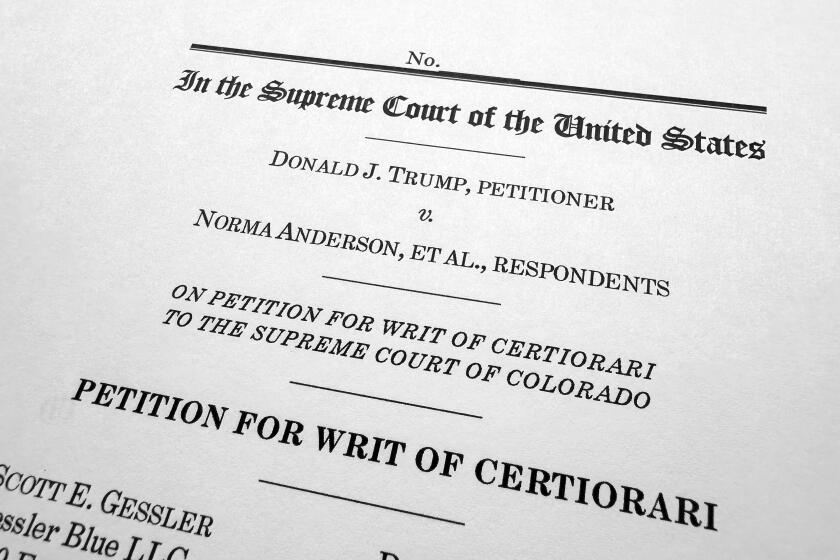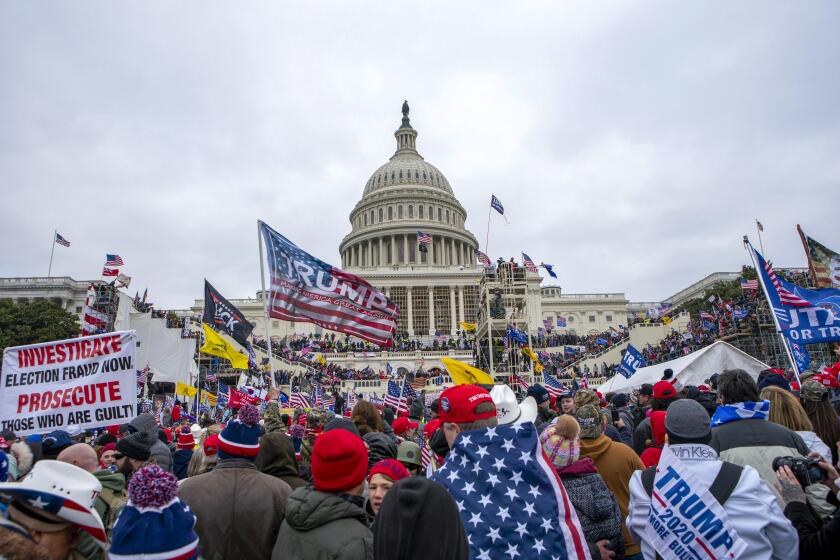Column: Texas’ defiance of federal rule echoes Southern segregationists — with a key difference

- Share via
Texas Gov. Greg Abbott’s years of defiance of federal rule has escalated to a standoff at the border with lives on the line. A Justice Department filing with the Supreme Court on Monday underscored the legal bankruptcy of Texas’ position as well as the high stakes of its intransigence.
Under his “Operation Lone Star” initiative, Abbott has unabashedly declared that the state will undertake wide-ranging efforts to prevent immigrants from crossing into Texas from Mexico and send them back if they do enter. He insists that “Texas has the sovereign authority to defend our borders.”
One small problem: It doesn’t. The Constitution unambiguously assigns regulation of immigration to the federal government. Federal law preempts state laws that purport to exercise immigration authority, and there is no serious argument to the contrary.
The former president’s disqualification for insurrection under the 14th Amendment in Colorado threatens to make a mess the justices will likely try to avoid.
Texas’ attempts to suggest otherwise are tissue-thin. Its leading argument appears to be that the influx of migrants from Mexico triggers the Constitution’s invasion clause, which requires the federal government to protect the states against invasion, supposedly entitling the Lone Star State to take military action notwithstanding federal law.
But Texas does have one thing going for its broader border campaign: the U.S. Court of Appeals for the 5th Circuit, which is by most accounts the most maverick of the 12 federal circuit courts.
Texas’ resistance to federal law has taken many forms and given rise to a series of lawsuits by the Biden administration. Texas has placed large buoys in the middle of the Rio Grande to impede crossing. It has fenced a large area along the river and prevented Border Patrol agents from entering critical areas. And it has enacted a law that purports to make illegal entry a state crime and give Texas power to deport migrants as of March.
Special counsel Jack Smith’s investigation yielded an indictment of the former president for his role in events surrounding the Jan. 6, 2021, Capitol riot.
The episode that prompted this week’s Supreme Court filing arises from a Texas lawsuit that significantly upped the ante. The suit charges that the Border Patrol’s removal of concertina wire that Texas erected amounted to an “ongoing, unlawful practice which undermines [Texas’] border security efforts.”
The lawsuit borders on silliness. If the Constitution’s supremacy clause means anything, it’s that state law can’t be used to defeat a legitimate federal law enforcement function.
The U.S. District Court denied Texas’ motion for a preliminary injunction because, among other reasons, the U.S. has sovereign immunity against such a state suit. But the 5th Circuit entered an immediate “administrative stay” and then an injunction pending appeal that barred the U.S. government from interfering with the fencing except for medical emergencies. In a breathtakingly cursory statement, the court held that Texas wasn’t regulating the Border Patrol and that sovereign immunity therefore did not apply.
The U.S. government filed an emergency motion to vacate the injunction with the Supreme Court this month, pointing out that the 5th Circuit was “manifestly wrong” under the supremacy clause and sovereign immunity principles. It added that the court’s rationale would allow states to “seek to force the federal government to conform the implementation of federal immigration law to varying state-law regimes.”
This week’s filing was the Justice Department’s second supplemental memorandum to its emergency motion, an extreme rarity. It was prompted by an episode that tragically substantiated the federal government’s concerns about Texas’ interference: Three migrants drowned trying to cross the border Friday, and Texas National Guard troops refused to give the Border Patrol access to the scene. (Texas disputes aspects of the federal account but not that the Border Patrol was blocked from entering the area.)
The essential dynamic is clear: Abbott and Texas are determined to continue to defy federal law enforcement regardless of the Constitution and the consequences. Indeed, there is a Trumpian swagger to Abbott’s insistence on supplanting federal law enforcement because it supposedly isn’t getting the job done on his terms.
We have seen this kind of state-federal law enforcement standoff in the South before, most notably by segregationist governors such as Orval Faubus, who used the Arkansas National Guard to block Black students from integrating Little Rock Central High School in 1957. It took a concerted effort from the federal government and the federal courts to beat back that lawlessness.
Abbott’s refusal to recognize the supremacy of federal law is as bold and rank as we have seen. The key difference here is the lack of resolve to apply the Constitution among the 5th Circuit’s judges, about a third of whom are Trump appointees. Despite its conservatism, the Supreme Court has taken an increasing number of cases from the circuit — it has at least six on its current docket — and reversed it about three-quarters of the time. Given that the other most conservative appellate court is reversed about half as often, that suggests the 5th Circuit is not just far right but downright wacky.
The Texas dispute shows how former President Trump’s depredations have outlasted his rule. That’s because he managed to seed the courts with a cohort of judges who have little allegiance to the federal judiciary’s tradition of reinforcing the supremacy of federal law. Their corrosive impact will linger for a generation or more.
Harry Litman is the host of the “Talking Feds” podcast. @harrylitman
More to Read
A cure for the common opinion
Get thought-provoking perspectives with our weekly newsletter.
You may occasionally receive promotional content from the Los Angeles Times.













